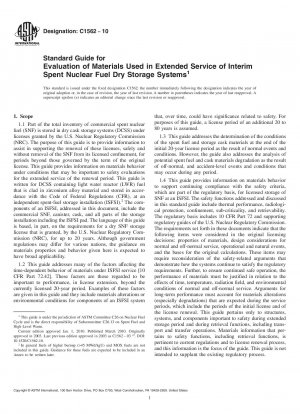ASTM C1562-10
Standard Guide for Evaluation of Materials Used in Extended Service of Interim Spent Nuclear Fuel Dry Storage Systems
- Standard No.
- ASTM C1562-10
- Release Date
- 2010
- Published By
- American Society for Testing and Materials (ASTM)
- Status
- Replace By
- ASTM C1562-10(2018)
- Latest
- ASTM C1562-10(2018)
- Scope
Information is provided in this document and other referenced documents to assist the licensee and the licensor in analyzing the materials aspects of performance of SNF and DCSS components during extended storage. The effects of the service conditions of the first licensing period are reviewed in the license renewal process. These service conditions are highlighted and discussed in Annex A1 as factors that affect materials performance in an ISFSI. Emphasis is on the effects of time, temperature, radiation, and the environment on the condition of the SNF and the performance of components of ISFSI storage systems.
The storage of SNF that is irradiated under the regulations of 10 CFR Part 50 is governed by regulations in 10 CFR Part 72. Regulatory requirements for the subsequent geologic disposal of this SNF are presently given in 10 CFR Part 60, with specific requirements for the use of Yucca Mountain as a repository being given in the regulatory requirements of 10 CFR Part 63. Between the life-cycle phases of storage and disposal, SNF may be transported under the requirements of 10 CFR Part 71. Therefore, in storage, it is important to acknowledge the transport and disposal phases of the life cycle. In doing this, the materials properties that are important to these subsequent phases are to be considered in order to promote successful completion of these subsequent phases in the life cycle of SNF. Retrievability of SNF (or high-level radioactive waste) is set as a requirement in 10 CFR Part 72.122(g)(5) and 10 CFR Part 72.122(l). Care should be taken in operations conducted prior to disposal, for example, storage, transfer, and transport, to ensure that the SNF is not abused and that SNF assemblies will be retrievable, the protective value of the cladding is not degraded and remains capable of serving as an active barrier to radionuclide release during transfer and transport operations. It is possible that cladding could be altered during dry storage. The hydrogen effects, fracture toughness of the cladding and the creep behavior are important parameters to be evaluated and controlled during the dry storage phase of the life cycle. These degradation mechanisms are discussed in Annex A2 and Annex A4.
1.1 Part of the total inventory of commercial spent nuclear fuel (SNF) is stored in dry cask storage systems (DCSS) under licenses granted by the U.S. Nuclear Regulatory Commission (NRC). The purpose of this guide is to provide information to assist in supporting the renewal of these licenses, safely and without removal of the SNF from its licensed confinement, for periods beyond those governed by the term of the original license. This guide provides information on materials behavior under conditions that may be important to safety evaluations for the extended service of the renewal period. This guide is written for DCSS containing light water reactor (LWR) fuel that is clad in zirconium alloy material and stored in accordance with the Code of Federal Regulations (CFR), at an independent spent-fuel storage installation (ISFSI). The components of an ISFSI, addressed in this document, include the commercial SNF, canister, cask, and all parts of the storage installation including the ISFSI pad. The language of this guide is based, in part, on the requirements for a dry SNF storage license that is granted, by the U.S. Nuclear Regulatory Commission (NRC), for up to 20 years. Although government regulations may differ for various nations, the guidance on materials properties and behavior given here is expected to have broad applicability.
1.2 This guide addresses many of the factors affecting the time-dependent behavior of materials under ISFSI service [10 CFR Part 72.42]. These factors are those regarded to be important to performance, in license extension, beyond the currently licensed 20-year period. Examples of these factors are given in this guide and they include materials al......
ASTM C1562-10 Referenced Document
- ASTM C1174 Standard Practice for Prediction of the Long-Term Behavior of Waste Package Materials Including Waste Forms Used in the Geologic Disposal of High-Level Nuclear Waste
- ASTM C227 Standard Test Method for Potential Alkali Reactivity of Cement-Aggregate Combinations (Mortar-Bar Method)
- ASTM C295 Standard Guide for Petrographic Examination of Aggregates for Concrete
- ASTM C33 Standard Specification for Concrete Aggregates
- ASTM C859 Standard Terminology Relating to Nuclear Materials
ASTM C1562-10 history
- 2018 ASTM C1562-10(2018) Standard Guide for Evaluation of Materials Used in Extended Service of Interim Spent Nuclear Fuel Dry Storage Systems
- 2010 ASTM C1562-10 Standard Guide for Evaluation of Materials Used in Extended Service of Interim Spent Nuclear Fuel Dry Storage Systems
- 2003 ASTM C1562-03e2 Standard Guide for Evaluation of Materials Used in Extended Service of Interim Spent Nuclear Fuel Dry Storage Systems
- 2003 ASTM C1562-03e1 Standard Guide for Evaluation of Materials Used in Extended Service of Interim Spent Nuclear Fuel Dry Storage Systems
- 2003 ASTM C1562-03 Standard Guide for Evaluation of Materials Used in Extended Service of Interim Spent Nuclear Fuel Dry Storage Systems
